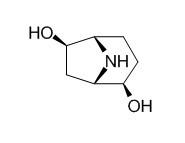Baogongteng C
Baogongteng A and Baogongteng C are the major toxic chemical compounds of the Erycibe species.
Inquire / Order:
manager@chemfaces.com
Technical Inquiries:
service@chemfaces.com
Tel:
+86-27-84237783
Fax:
+86-27-84254680
Address:
1 Building, No. 83, CheCheng Rd., Wuhan Economic and Technological Development Zone, Wuhan, Hubei 430056, PRC
Providing storage is as stated on the product vial and the vial is kept tightly sealed, the product can be stored for up to
24 months(2-8C).
Wherever possible, you should prepare and use solutions on the same day. However, if you need to make up stock solutions in advance, we recommend that you store the solution as aliquots in tightly sealed vials at -20C. Generally, these will be useable for up to two weeks. Before use, and prior to opening the vial we recommend that you allow your product to equilibrate to room temperature for at least 1 hour.
Need more advice on solubility, usage and handling? Please email to: service@chemfaces.com
The packaging of the product may have turned upside down during transportation, resulting in the natural compounds adhering to the neck or cap of the vial. take the vial out of its packaging and gently shake to let the compounds fall to the bottom of the vial. for liquid products, centrifuge at 200-500 RPM to gather the liquid at the bottom of the vial. try to avoid loss or contamination during handling.
PLoS One.2022, 17(6):e0268505.
Cancers (Basel).2023, 15(1):37.
J of L. Chroma.&Related Tech2017, 252-258
Proc Biol Sci.2024, 291(2015):20232578.
Cell Death Dis.2019, 10(12):882
Front Immunol.2017, 8:1542
Am J Chin Med.2015, 30:1-22
Environ Toxicol.2020, doi: 10.1002
Korean Herb. Med. Inf. 2016, 4(1):35-42
J Nat Sc Biol Med2019, 10(2):149-156
Related and Featured Products
Regul. Toxicol. Pharm. 2014, 70(1):349-56
Toxicology and the chemical foundation of plants of Erycibe.[Pubmed:
25073109]
Erycibe is a relatively small genus in the family Convolvulaceae with over 10 identified species. Some Erycibe plant species are purportedly toxic at high doses. However, few toxicology studies have been conducted on those species.
METHODS AND RESULTS:
In this study, the toxicity of 40% ethanolic extracts of Erycibeobtusifolia, Erycibeschmidtii, and Erycibeellipptimba was evaluated. E. ellipptimba has been reported to be more toxic due to containing larger amounts of Baogongteng C, an alkaloid with known toxicity. Thus, E. ellipptimba was chosen for further toxicology study here. An HPLC-MS method was developed to identify the main components and determine the percentages of Baogongteng C in total alkaloid of E. ellipptimba (EWA). The toxicity of total alkaloid and Baogongteng C was evaluated and compared.
CONCLUSIONS:
The results indicated that Baogongteng A and Baogongteng C are the major toxic chemical compounds of the Erycibe species tested. The results also suggest EWA is cholinergic. Finally, in a subacute toxicity study of EWA, alterations observed with high dosage suggest that the liver and kidney could be the target organs of toxicity.



